
Back Turkse lekker Afrikaans راحة الحلقوم Arabic ملبن ARZ Lokum Azerbaijani Лукум Bashkir Лукум Byelorussian Локум Bulgarian Loukoum Breton Rahatlokum BS Delícies turques Catalan
 An assortment of Turkish delight on display in Istanbul | |
| Type | Confection |
|---|---|
| Place of origin | Safavid (Name of Iran)[1] or the Ottoman Empire (Turkey)[2] |
| Serving temperature | Room temperature |
| Main ingredients | Starch, sugar[3][4][5] |
| Ingredients generally used | Fruit, nuts, honey |
| Variations | Multiple |
Turkish delight, or lokum (/lɔ.kʊm/) is a family of confections based on a gel of starch and sugar. Premium varieties consist largely of chopped dates, pistachios, hazelnuts or walnuts bound by the gel; traditional varieties are often flavored with rosewater, mastic gum, bergamot orange, or lemon. Other common flavors include cinnamon and mint. The confection is often packaged and eaten in small cubes dusted with icing sugar, copra, or powdered cream of tartar to prevent clinging. In the production process, soapwort may be used as an emulsifying additive.[6]
The origin of lokum is not precisely known, though the confection is known to have been produced in the Ottoman Empire, Greece and Greek populations in Asia Minor[7] and Safavid Azerbaijan since the late 18th century.
- ^ Cite error: The named reference
temptationwas invoked but never defined (see the help page). - ^ Roufs, Timothy G.; Roufs, Kathleen Smyth (2014). Sweet Treats around the World: An Encyclopedia of Food and Culture. ABC-CLIO. pp. 343–346. ISBN 978-1-61069-220-5.
- ^ "طريقة عمل الملبن السوري الشهير". Dlwaqty (in Arabic). Retrieved 1 October 2023.
- ^ "مقادير وطريقة عمل الملبن". موضوع (in Arabic). Retrieved 1 October 2023.
- ^ Grimes, Lulu. "Turkish delight". GoodFood. BBC. Retrieved 16 November 2023.
- ^ "Loukoumi: Traditional Greek Candy". Mykonos Life. Retrieved 2024-06-06.
- ^ "The Fascinating History of Greek Loukoumia, or Turkish Delights". Greek Reporter.
© MMXXIII Rich X Search. We shall prevail. All rights reserved. Rich X Search